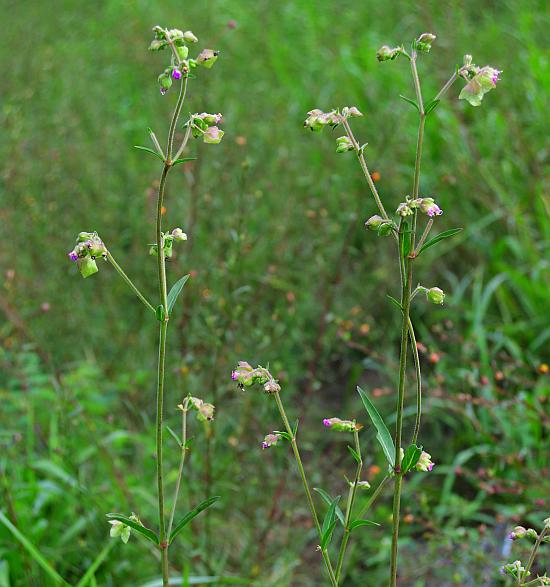Mirabilis albida (Walter) Heimerl
White Four-o'Clock

Native
CC = 5
CW = 5
MOC = 73
© SRTurner
Mirabilis albida (Walter) HeimerlWhite Four-o'Clock | |
 |
Native CC = 5 CW = 5 MOC = 73 |
© SRTurner |
|
Family - Nyctaginaceae Habit - Perennial forb with woody roots. Stems - Erect, to 1.0 m, glabrous to densely hairy, the hairs often in 2 vertical bands, when hairy sometimes also glandular, when glabrous appearing light brown, tan or silvery-whitened.
Leaves - Opposite, simple, entire, sessile or with a short petiole less than 1 cm. Blades 3-10 cm long, linear to more commonly lanceolate or oblong-elliptic, rarely narrowly ovate, narrowed or tapered at the base, narrowed or abruptly tapered to a rounded or bluntly pointed (rarely sharply pointed) tip, glabrous to densely hairy, sometimes also somewhat glandular, when glabrous the undersurface pale or glaucous.
Inflorescences - Terminal and axillary, or sometimes only axillary. Flower clusters with 2-5 flowers, subtended by a calyxlike involucre of fused bracts. Involucre 4-5 mm long at flowering, glabrous or sparsely to densely hairy on the surfaces, sometimes also glandular, becoming enlarged to 8-12 mm long at fruiting, broadly bell-shaped at maturity, with 5 broad shallow lobes, persistent, somewhat flattened, and somewhat papery at fruiting.
Flowers - Perfect, actinomorphic, rarely seen fully expanded. Calyx 6-10 mm long, 5-lobed, white to pink, the expanded portion bell-shaped to saucer-shaped at flowering, the lobes notched at the tip. Petals absent. Stamens 1-5, the filaments free or sometimes fused into a ring at the base, the anthers attached basally. Pistil 1 per flower, the ovary superior but appearing inferior because of the closely enveloping perianth tube, consisting of 1 carpel, with 1 locule, the placentation basal. Style 1, the stigma globose or disclike. Ovule 1.
Fruits - Achenes surrounded by the persistent, hardened or somewhat fleshy perianth tube, 4-6 mm long, noticeably warty on the angles and sides, each tubercle of the angles with a tuft of short hairs at the tip, otherwise minutely hairy, olive green to dark brown.
Flowering - May - October. Habitat - Upland prairies, sand prairies, glades, tops and ledges of bluffs, streambanks, upland forest openings, pastures, roadsides, railroads, open disturbed areas. Origin - Native to the U.S. Lookalikes - M. nyctaginea, which is more common. Other info. - This inconspicuous species is found in most counties south of the Missouri River, less commonly in the north. Its range in the continental U.S. is somewhat unusual, comprising a broad north-south band through about the center third of the country. The plant is recognized by its unusual persistent involucres, which are papery and contain the tiny fruits at their centers (though these are easily dislodged). The whitened involucres are sometimes believed to be the flowers, and are probably responsible for the somewhat deceptive common name. The plant is differentiated from the more common M. nyctaginea by its leaves. Leaves of M. nyctaginea are broader, with longer and well-defined petioles. The fruits are also different, with those of M. albida being noticeably warty on the angles (use magnification to see this clearly) Photographs taken at Sand Prairie Conservation Area, Scott County, MO, 8-15-2021 (SRTurner). |